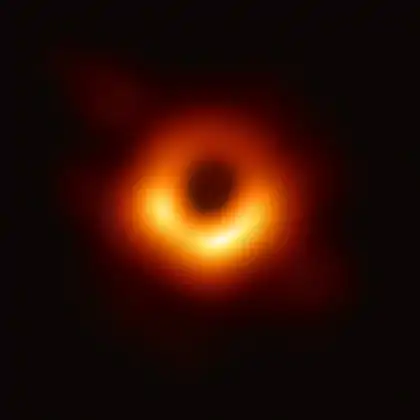Planck star
In loop quantum gravity theory, a Planck star is a hypothetical astronomical object, theorized as a compact, exotic star, that exists within a black hole's event horizon, that is created when the energy density of a collapsing star reaches the Planck energy density. Under these conditions, assuming gravity and spacetime are quantized, there arises a repulsive 'force' derived from Heisenberg's uncertainty principle. The accumulation of mass-energy inside the Planck star cannot collapse beyond this limit because it violates the uncertainty principle for spacetime itself.[1]
The key feature of this theoretical object is that this repulsion arises from the energy density, not the Planck length, and starts taking effect far earlier than might be expected. This repulsive 'force' is strong enough to stop the collapse of the star well before a singularity is formed and, indeed, well before the Planck scale for distance. Since a Planck star is calculated to be considerably larger than the Planck scale, this means there is adequate room for all the information captured inside of a black hole to be encoded in the star, thus avoiding information loss.[1]
While it might be expected that such a repulsion would act very quickly to reverse the collapse of a star, it turns out that the relativistic effects of the extreme gravity such an object generates slow down time for the Planck star to a similarly extreme degree. Seen from outside the star's Schwartzschild radius, the rebound from a Planck star takes approximately fourteen billion years, such that even primordial black holes are only now starting to rebound from an outside perspective.[2] Furthermore, the emission of Hawking radiation can be calculated to correspond to the timescale of gravitational effects on time, such that the event horizon that 'forms' a black hole evaporates as the rebound proceeds.[1]
The existence of Planck stars was first proposed by Carlo Rovelli and Francesca Vidotto, who theorized in 2014 that Planck stars form inside black holes[3] as a solution to the black hole firewall and black hole information paradox. Confirmation of emissions from rebounding black holes could possibly provide evidence for loop quantum gravity.[2] Recent work demonstrates that Planck stars may exist inside of black holes as part of a cycle between black hole to white hole.[4]
A somewhat analogous object theorized under string theory is the fuzzball, which similarly eliminates the singularity within a black hole and accounts for a way to preserve the quantum information that falls into a black hole's event horizon.
References
- "New Type of Star Emerges From Inside Black Holes". Physics arXiv Blog. 5 February 2014. Retrieved 8 September 2018.
- Resonance Science Foundation Research Team. "Planck Stars: Quantum gravity research ventures beyond the event horizon". Retrieved 10 December 2018.
- Rovelli, Carlo; Vidotto, Francesca (2014). "Planck stars". International Journal of Modern Physics D. 23 (12): 1442026. arXiv:1401.6562. Bibcode:2014IJMPD..2342026R. doi:10.1142/S0218271814420267. S2CID 118917980.
- Carlo Rovelli (10 December 2018). "Viewpoint: Black Hole Evolution Traced Out with Loop Quantum Gravity". Retrieved 11 December 2018.
